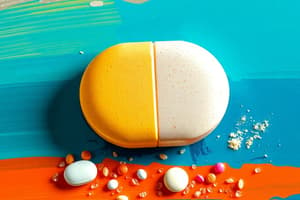Podcast
Questions and Answers
What is the primary focus of Quality Control (QC) in pharmaceutical manufacturing?
What is the primary focus of Quality Control (QC) in pharmaceutical manufacturing?
- Overseeing general manufacturing processes
- Training staff on quality assurance methodologies
- Establishing preventive measures for product defects
- Ensuring consistency and compliance with standards (correct)
Which solid dosage form is created by compressing a mixture of active pharmaceutical ingredients and excipients?
Which solid dosage form is created by compressing a mixture of active pharmaceutical ingredients and excipients?
- Granules
- Tablets (correct)
- Capsules
- Lozenges
What distinguishes hard shelled capsules from soft shelled capsules?
What distinguishes hard shelled capsules from soft shelled capsules?
- Hard shelled capsules contain powder (correct)
- Soft shelled capsules are made of a mixture of APIs and excipients
- Hard shelled capsules contain oil
- Soft shelled capsules are used for buccal administration
Which of the following is NOT a type of tablet listed in the content?
Which of the following is NOT a type of tablet listed in the content?
What is the purpose of sampling and testing in Quality Control?
What is the purpose of sampling and testing in Quality Control?
Lozenges are characterized by which of the following properties?
Lozenges are characterized by which of the following properties?
Which of the following solid dosage forms is specifically applied rectally?
Which of the following solid dosage forms is specifically applied rectally?
Quality Assurance (QA) differs from Quality Control (QC) in that QA primarily focuses on which aspect?
Quality Assurance (QA) differs from Quality Control (QC) in that QA primarily focuses on which aspect?
What is the main purpose of the dissolution test in tablet evaluation?
What is the main purpose of the dissolution test in tablet evaluation?
Which of the following factors is NOT monitored during the dissolution test?
Which of the following factors is NOT monitored during the dissolution test?
Which test specifically evaluates a tablet's resistance to abrasion and chipping?
Which test specifically evaluates a tablet's resistance to abrasion and chipping?
What role does in-process control play in tablet production?
What role does in-process control play in tablet production?
Which instrument is essential for measuring the dimensions of tablets?
Which instrument is essential for measuring the dimensions of tablets?
During the visual inspection of tablets, which of the following is NOT typically checked?
During the visual inspection of tablets, which of the following is NOT typically checked?
What does the hardness test evaluate in relation to tablets?
What does the hardness test evaluate in relation to tablets?
What is a key acceptance criterion for the dissolution test?
What is a key acceptance criterion for the dissolution test?
What does the Weight Uniformity test primarily ensure in tablet quality control?
What does the Weight Uniformity test primarily ensure in tablet quality control?
Which step in the Weight Uniformity test involves assessing the average weight of the sample?
Which step in the Weight Uniformity test involves assessing the average weight of the sample?
What does content uniformity measure in tablet quality control?
What does content uniformity measure in tablet quality control?
Why is mechanical strength important in the quality control of tablets?
Why is mechanical strength important in the quality control of tablets?
Which of the following statements about the Dissolution test is true?
Which of the following statements about the Dissolution test is true?
What is the purpose of random selection in the weight uniformity test?
What is the purpose of random selection in the weight uniformity test?
Which aspect is NOT assessed by the Quality Control procedures listed?
Which aspect is NOT assessed by the Quality Control procedures listed?
What does the term 'Acceptance Criteria' refer to in the weight uniformity test?
What does the term 'Acceptance Criteria' refer to in the weight uniformity test?
What is the acceptance criterion for tablets weighing more than 250 mg regarding deviations from the average weight?
What is the acceptance criterion for tablets weighing more than 250 mg regarding deviations from the average weight?
How should the average weight be calculated based on individual weights?
How should the average weight be calculated based on individual weights?
What percentage deviation is acceptable for a tablet weighing 60 mg?
What percentage deviation is acceptable for a tablet weighing 60 mg?
Which of the following is NOT a cause of weight variations in tablets?
Which of the following is NOT a cause of weight variations in tablets?
What is the criterion for compliance in the content uniformity test for ten tablets?
What is the criterion for compliance in the content uniformity test for ten tablets?
Flashcards
What is Quality Assurance (QA)?
What is Quality Assurance (QA)?
Quality Assurance (QA) ensures product quality throughout the manufacturing process by establishing a system to prevent defects.
What is Quality Control (QC)?
What is Quality Control (QC)?
Quality Control (QC) is a part of QA that directly tests and monitors products to ensure they meet set standards.
What are tablets?
What are tablets?
Tablets are solid dosage forms created by compressing a mixture of active ingredients and excipients.
What are capsules?
What are capsules?
Signup and view all the flashcards
What are granules?
What are granules?
Signup and view all the flashcards
What are lozenges?
What are lozenges?
Signup and view all the flashcards
What are suppositories?
What are suppositories?
Signup and view all the flashcards
Weight Uniformity Test
Weight Uniformity Test
Signup and view all the flashcards
Content Uniformity Test
Content Uniformity Test
Signup and view all the flashcards
Deviation
Deviation
Signup and view all the flashcards
Acceptance Criteria
Acceptance Criteria
Signup and view all the flashcards
Deviation (%)
Deviation (%)
Signup and view all the flashcards
Mechanical Strength Test
Mechanical Strength Test
Signup and view all the flashcards
Dissolution Test
Dissolution Test
Signup and view all the flashcards
Suppositories
Suppositories
Signup and view all the flashcards
Sampling for Weight Uniformity Test
Sampling for Weight Uniformity Test
Signup and view all the flashcards
Individual Weighing for Weight Uniformity Test
Individual Weighing for Weight Uniformity Test
Signup and view all the flashcards
Deviation Calculation for Weight Uniformity Test
Deviation Calculation for Weight Uniformity Test
Signup and view all the flashcards
Hardness Test
Hardness Test
Signup and view all the flashcards
Friability Test
Friability Test
Signup and view all the flashcards
In-Process Control
In-Process Control
Signup and view all the flashcards
Analytical Balance
Analytical Balance
Signup and view all the flashcards
Dissolution Apparatus
Dissolution Apparatus
Signup and view all the flashcards
Hardness Tester
Hardness Tester
Signup and view all the flashcards
Friability Tester
Friability Tester
Signup and view all the flashcards
Study Notes
Quality Control in Pharmaceutical Manufacturing: Solid Dosage Forms
- Quality control (QC) is crucial in pharmaceutical manufacturing. It ensures the safety, efficacy, and consistency of medicinal products.
- This presentation focuses on QC procedures for solid dosage forms, specifically tablets.
- Tablets are a prevalent dosage form in the pharmaceutical industry.
Understanding Quality Control in Pharmaceutical Manufacturing
- Quality Assurance (QA) aims to prevent product defects. It creates a system for ensuring quality throughout the manufacturing process.
- QC is part of QA, focusing on the direct testing and monitoring of products.
- QC ensures that manufactured products meet predefined standards. It involves sampling, testing, documentation, and analysis to identify deviations.
Solid Dosage Forms
- Tablets: Made by compressing a mix of active pharmaceutical ingredients (APIs) and excipients. They come in various forms (buccal, sublingual, chewable, enteric-coated, effervescent).
- Capsules: Enclose APIs and excipients in a shell (either powder or granule form). Two types: hard-shelled (contains powder) and soft-shelled (contains oil).
- Granules: Dry preparations with a definite particle size, made from APIs and suitable excipients.
- Lozenges: Hard medicines that dissolve slowly in the mouth, prolonging the effects of the medicine at the site of action (e.g., antiseptic, antitussive).
- Suppositories: Solid dosage forms applied to the rectum. Composed of an active ingredient in a suppository base.
Quality Control of Tablets: A Comprehensive Approach
- Weight Uniformity: Ensures each tablet contains the correct dosage of active ingredient, ensuring consistent therapeutic efficacy.
- Content Uniformity: Determines the accuracy of active ingredient content in individual tablets, ensuring consistent dosage.
- Dissolution: Evaluates how readily the active ingredient dissolves from the tablet, impacting bioavailability and effectiveness in the body.
- Mechanical Strength: Measures the tablet's hardness and resistance to breakage during handling and manufacturing.
Weight Uniformity Test: Ensuring Consistent Dosage
- Sampling: Randomly select 20 tablets from the batch.
- Individual Weighing: Weigh each tablet accurately.
- Deviation Calculation: Calculate percentage deviation from the average weight.
- Acceptance Criteria: Compare deviations to established standards to ensure compliance.
Weight Uniformity Test: Aspacid 75 mg
- Sampling: Randomly select 20 tablets from the production run.
- Calculate individual and average weighing: Sum of the weights divided by 20.
- Deviation calculation: ((Individual weight-Average Weight) / Average Weight)*100
Acceptance Criteria
- Tablets weighing 80 mg or less, deviations should not exceed ±10%.
- Tablets between 80-250 mg, deviations should not exceed ±7.5%.
- Tablets over 250 mg, deviations should not exceed ±5%.
- The test is considered passed if not more than two tablets deviate beyond the acceptable limit, and none exceeds double the limit.
Causes for Weight Variations
- Size and distribution of granules (being compressed).
- Poor flow and high-speed turret speed (incomplete filling).
- Poor mixing (uneven distribution of lubricants and glidants).
- Variability in lower punch length (inconsistent fill).
Content Uniformity Test: Method
- Sampling: Randomly select 30 tablets from batch (for tablets less than or equal to 40 mg).
- Initial Assay: Determine the average content of active ingredient in 10 tablets by analysis.
- Acceptance Criteria: Individual tablet content must fall within ± 15% for content less than or equal to 40 mg and between 75% to 125% range for any individual to comply with the test.
- Further Assay: Assay the remaining 20 tablets for a full batch uniformity analysis.
Dissolution Test: Evaluating Active Ingredient Release
- Purpose: Assesses how rapidly the active ingredient dissolves.
- Methodology: Immersing tablets in a simulated fluid at controlled temperatures and stirring speeds.
- Acceptance Criteria: Ensures the active ingredient dissolves within specified timeframes and extent.
Mechanical Strength: Ensuring Tablet Integrity
- Hardness Test: Evaluates tablet resistance to crushing and breakage.
- Friability Test: Measures tablet's resistance to abrasion during handling and transport.
Visual Inspection: Ensuring Tablet Appearance and Uniformity
- Appearance: Checks for discoloration, defects, or inconsistencies.
- Shape: Verifies consistency with specifications, free from distortions.
- Size and Dimensions: Measures diameter and thickness using instruments (e.g., vernier calipers) to check uniformity within the batch.
In-Process Control: Maintaining Quality Throughout Production
- Continuous monitoring and adjustment of critical parameters during manufacturing.
- Helps minimize manufacturing deviations and ensure product consistency.
Essential Instruments for Quality Control
- Analytical Balances: Precision measurement of weights.
- Dissolution Apparatus: Testing how quickly the active ingredients dissolve.
- Disintegration Tester: Assessment of whether the tablet breaks into smaller particles.
- Hardness Tester: Measures the hardness of the tablets.
- Friability Tester: Measures the resistance of the tablets to abrasion.
- Vernier Caliper or Micrometer: Measuring tablets' dimensions for uniformity.
- UV-Vis Spectrophotometer: Instrumental analysis of the active ingredient or other components being assessed.
Studying That Suits You
Use AI to generate personalized quizzes and flashcards to suit your learning preferences.




